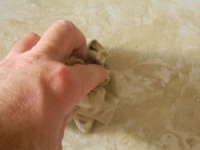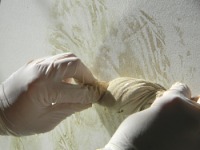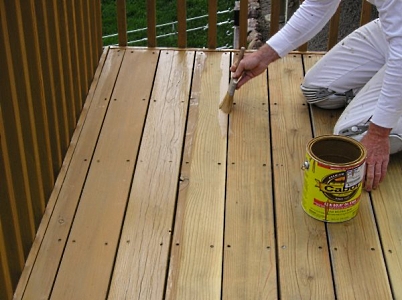Faux rag painting is one of the easiest and most popular decorative painting techniques around. Depending on the type of rag used, the pattern can vary tremendously. So can the color combinations.
Choosing Colors
Color combinations that work are limited only by your imagination, though using a color wheel can be helpful. You achieve subtle faux rag finishes by using paint and glaze in similar colors. You produce more dramatic and even wild effects when you use paints that contrast with each other.
Layering colors produces deeper, more complex shades than you would achieve using a single layer of paint.
- Applying warm colors like yellow, orange, and red over a neutral base coat creates a cozy feeling.
- Using blue, green, or purple over white or gray produces a much cooler effect.
Another way to enhance your room is to layer a primary color over a secondary color.
- Blue glaze over a purple basecoat produces a rich grape shade.
- Blue over green produces a deep forest green.
- Blue over orange produces a mixture of warm and cool browns depending on the thickness of the glaze.
- Yellow over orange produces a cheerful sunny color.
- Yellow over green produces a fresh spring-like green.
Monochromatic effects are also nice.
- Dark brown glaze over tan or beige produces a nice neutral background for most decorating schemes.
- Alternatively, a beige wash over tan produces a different neutral, subtle effect.
As a rule of thumb, applying a dark color over a light one produces a dramatic effect, while light colors applied over dark ones create a more subtle finish.
Choosing Materials
The faux ragging paint technique requires very few materials. In addition to basic interior paint tools for laying down the base coat, you’ll need glaze or wash and clean, non-shedding rags.
Rags
Old T-shirts are good for ragging but consider other materials as well.
- Corduroy
- Terrycloth
- Burlap
- Chamois
- Aluminum foil
- Plastic bags, sheeting, or saran wrap
- Newspaper
Thinned Paint or Glaze
Using thinned latex paint as wash is less inexpensive than using glaze. This can make it attractive price wise. As a faux rag top coat, you need to realize that a latex paint wash will produce a different effect than using a glaze will. Washes are more opaque than glazes, so they won’t let the bottom color come through a distinctly. This can be a used for excellent results. Creating your own washes and glazes isn’t difficult.
Use glaze when you want the bottom color to show through, or you want a translucent effect.
Now that you know what you need to have on hand, consider the effect you want. It will also help you decide which type of “rag” to use. It will also determine whether using thinned latex paint or using a glaze will give you the look you want.
For example, burlap will leave a fabric-like texture behind in some areas if it is scrunched only in certain places. Corduroy can leave fine lines behind. Plastic sheeting makes it easier to create larger patterns, while a plastic bag or plastic wrap enables small crinkles. Terrycloth leaves yet another distinctive texture behind.
Technique
After preparing the surface and masking, apply two coats of eggshell or satin paint. Allow the second coat to dry completely. Don’t use flat paint as it will absorb too much of the glaze.
You’re ready to begin ragging!
There are basically two types of faux rag techniques: ragging off and ragging on.
Ragging Off
 Ragging off involves applying a layer of glaze or wash directly to the wall, then using the rag to remove some of it. Ragging on is the opposite. The color is applied directly to the rag, then dabbed or rolled onto the wall.
Ragging off involves applying a layer of glaze or wash directly to the wall, then using the rag to remove some of it. Ragging on is the opposite. The color is applied directly to the rag, then dabbed or rolled onto the wall.
If you decide you prefer the look ragging off gives you, find someone else to work with you. It’s much easier with two people, because acrylic glazes dry very quickly. The first person should use a roller to apply a thin, even coat of glaze to the wall, working from top to bottom. Then, the second person uses the crumpled rag in a pouncing motion to remove a portion of the glaze.
The first person continues to apply glaze along the wet edge, while the second person works quickly to ensure the glaze doesn’t have time to dry.
This method produces more subtle results than ragging on.
Ragging On
 Ragging on requires more rags, because you dip the rag directly into the glaze or paint. The cloth absorbs more paint when you do this. Change the rag before it gets too saturated. A sopping wet rag can cause drips and problems with too-heavy application.
Ragging on requires more rags, because you dip the rag directly into the glaze or paint. The cloth absorbs more paint when you do this. Change the rag before it gets too saturated. A sopping wet rag can cause drips and problems with too-heavy application.
Tips for Successful Rag Painting
- Always keep the leading edge wet. Wet glaze applied over dry will create visible marks.
- Keep a damp sponge handy to keep the untextured areas wet.
- Have a squirt bottle handy to keep the glaze/paint mix workable.
- Time your project so that you can complete an entire wall without stopping. If you can do the whole room uninterrupted, even better.
- Pay special attention to corners and the areas near trim, windows, and doors. These spots are easy to miss and untreated spots will be obvious when the wash or glaze dries.
- Be sure to change the rag’s position frequently, straightening and re-crumpling it to create random patterns.
You may wish to apply several layers of a wash or glaze, or use several colors. Make sure each layer is completely dry before applying another coat.
Faux rag painting is an especially forgiving technique. Feel free to experiment with color, texture, and application technique until you achieve an effect you like!



5 Responses
What colors were used in the main example at the top of the page? Thanks!
I will be using three distinct colors on the same wall. However, each color will have its own dominant area ex sea foam green in the upper left quadrant, limestone in the upper right, amber in the lower right and a morphing in the lower left. Since the colors will overlap and collide at the borders, what tint of glaze should I use? Typically, I’m told to use a glaze darker/lighter than the base coat. But what if I have three distinct base coats?
You will need to choose a 4th color for the glaze. Something neutral and goes with the other colors. Can be darker or lighter. Recommend experimenting a bit with a color sample board; stripes of your dominate colors and sample cans for the glaze on poster board.
can you make a wash from semi-gloss paint??
I just painted my room with a semi gloss paint, but it badly needs texture. id like to be able to use some paint I already have on hand to rag with
Yes, this is fine. Use a glaze to “thin” the paint.